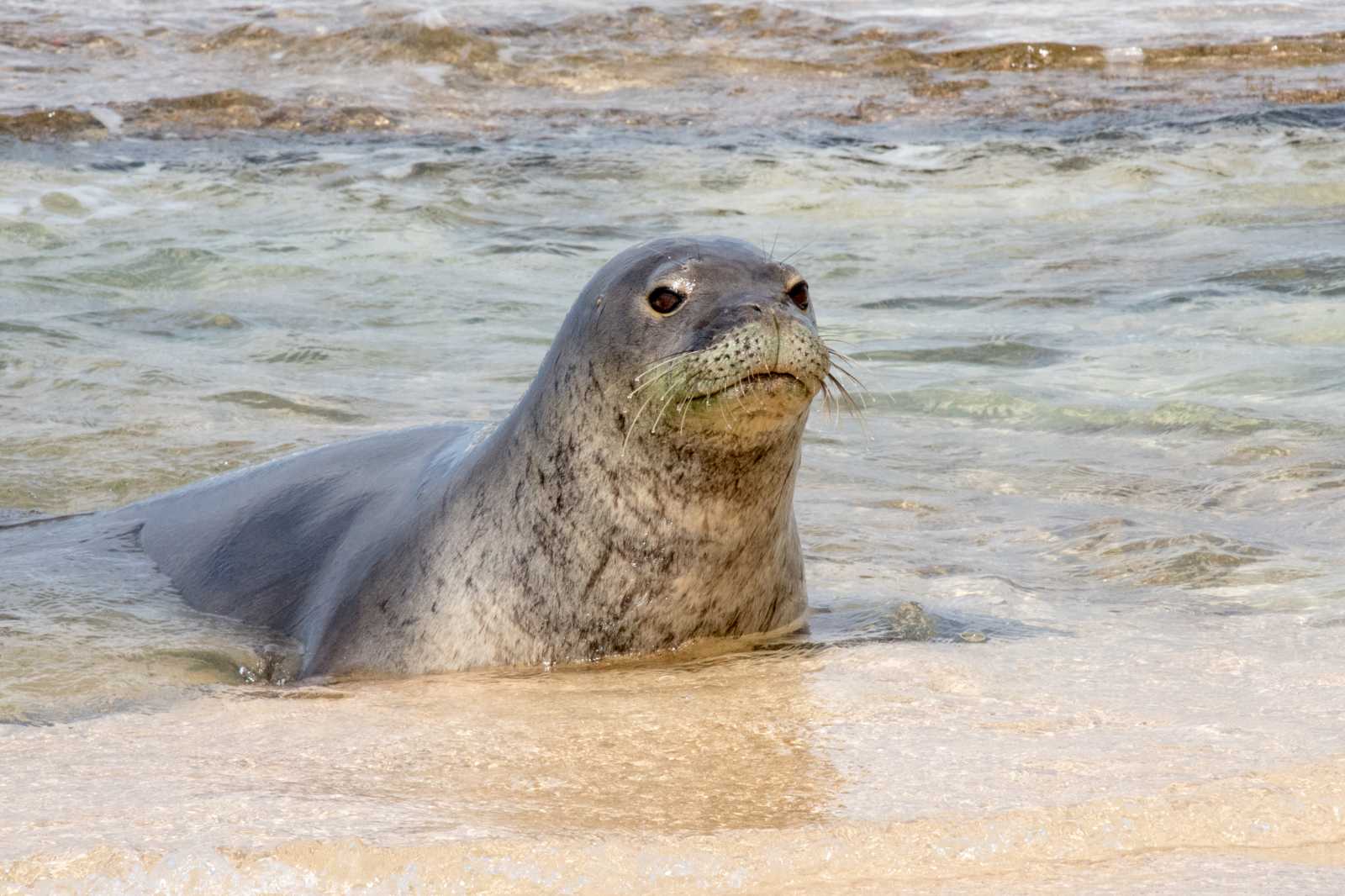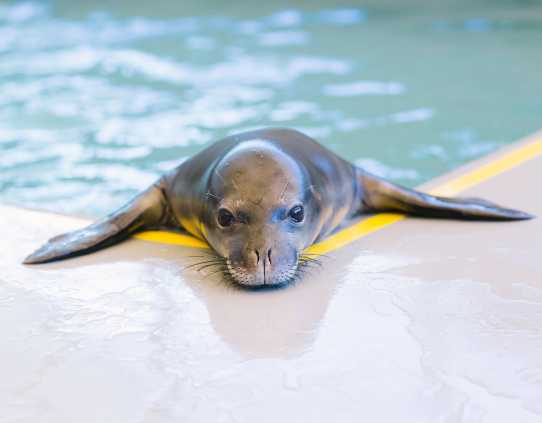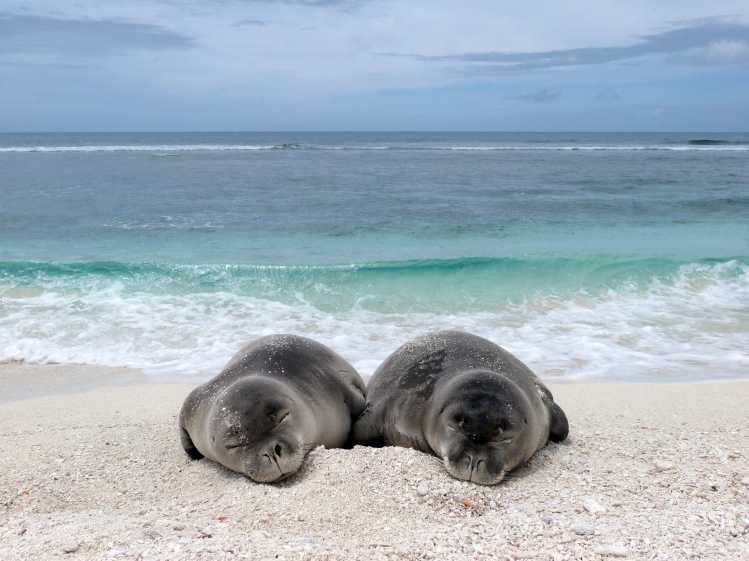
Hawaiian Monk Seal
Neomonachus schauinslandi
Learn More About Monk Seals
The Hawaiian monk seal population has only about 1,500 individuals, making it the most endangered seal or sea lion species in the United States. But thanks to conservation efforts, this species is making a slow recovery.
Female monk seals are slightly larger than males, but on average adult Hawaiian monk seals weigh between 375 to 450 pounds and can be 7 to 7.5 feet in length.
Hawaiian monk seals are born at about 35 pounds and 3 feet long, sporting a black coat of fur. As pups age, they shed this dark fur for a silvery-gray coat, with lighter creamy coloration on their underside.
Additional light patches and red and green tinged coloration from attached algae are common among adults. Their backs may also become darker with age, especially among males. Other distinctive features include their ear holes and short front flippers, which help them crawl on their belly (also known as “galumphing”) when on land.
What do they sound like?
Meet Our Patient: ‘Ākulikuli
Hawaiian monk seal pup ‘Ākulikuli was found skinny, malnourished and all alone. As a member of one of the most endangered species, it was crucial that ‘Ākulikuli get the medical care he needed to survive.
Once at our hospital ‘Ākulikuli was given nutritious fish-mash smoothies until he was strong enough to eat whole fish. Over time, this young pup was given special enrichment activities to help him develop the natural behaviors and skills he would need to have the best chance at life in the wild. After a few months of care ‘Ākulikuli was released back to his ocean home.
photo © The Marine Mammal Center / NOAA permit #18786

The greatest threats to marine mammals are caused by people, but we can also be their greatest champions.
Sign up for email from The Marine Mammal Center to stay updated on how you can be an advocate and champion for marine mammals like Hawaiian monk seals.
Habitat & Population Status
The Hawaiian monk seal is endemic to Hawai‘i, meaning they are native to the Hawaiian Islands and are not found anywhere else in the world. Their ancient Hawaiian name is ‘llio holo I ka uaua meaning "dog that runs in rough water."
A small population of these seals reside among the Main Hawaiian Islands—at any given time, up to 10 monk seals can be found on the Big Island, which is where Ke Kai Ola, our Hawaiian monk seal hospital, is located.
However, the majority of Hawaiian monk seals live in six main breeding subpopulations in the Northwestern Hawaiian Islands at Kure Atoll, Midway Islands, Pearl and Hermes Reef, Lisianski Island, Laysan Island and French Frigate Shoals.
Smaller breeding sub-populations are also seen on Necker Island and Nihoa Island, as well as Gardner Pinnacles and Maro Reef. Most of this population is within the Papahānaumokuākea Marine National Monument, which was designated in 2006.
Hunted to the brink of extinction in the late 19th century, the Hawaiian monk seal population declined for many years. Fortunately, the species has started to show an increase in numbers as conservations efforts have increased.
In fact, about 30 percent of today’s Hawaiian monk seal population is alive directly due to conservation efforts led by the National Oceanic and Atmospheric Administration (NOAA) and their partners like us.
The main threats Hawaiian monk seals face in the Northwestern Hawaiian Islands are maternal separation, malnutrition, predation, habitat loss and entanglement or ingestion of ocean trash. Those that live in the Main Hawaiian Islands face additional threats like toxoplasmosis and negative human interactions.

Breeding & Behavior
Female Hawaiian monk seals generally sexually mature at age 5 or 6, but it is unknown when males reach sexual maturity. A pregnant monk seal will carry her pup for 10 to 11 months before giving birth during late March to early April, though births have been recorded year-round.
A newborn Hawaiian monk seal typically nurses with its mother for about one month. During the nursing period, the mother stays with her pup without leaving to forage for food (similar to northern elephant seals) after which the pup is left on its own to learn to swim and find food.
Although they are generally solitary animals, female monk seals have been observed fostering the offspring of other seals.
As a species that spends about two-thirds of its life at sea, Hawaiian monk seals come to shore mainly to birth and rest. Sandy, protected beaches surrounded by shallow waters are preferred for pupping.
Their time spent in the water is primarily in areas surrounding atolls, islands and areas farther offshore like reefs and submerged banks. Monk seals have also been found using deep water coral beds as foraging habitat.
Monk seals generally hunt for food outside of the immediate shoreline areas in waters 60 to 300 feet deep. However, they are known to forage deeper than 1,000 feet, where they prey on eels and other benthic, or bottom-dwelling, organisms like fish, cephalopods and crustaceans.
A monk seal’s diet varies by factors such as location, sex and age. Adults are generally nocturnal hunters while juveniles spend more time hunting species that hide in the sand or under rocks during the day.

















